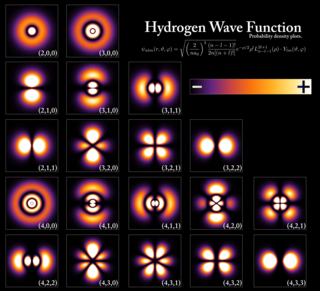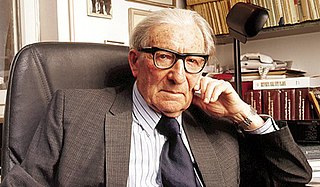The Copenhagen interpretation is an expression of the meaning of quantum mechanics that was largely devised from 1925 to 1927 by Niels Bohr and Werner Heisenberg. It is one of the oldest of numerous proposed interpretations of quantum mechanics, and remains one of the most commonly taught.

Physics is a branch of science whose primary objects of study are matter and energy. Discoveries of physics find applications throughout the natural sciences and in technology, since matter and energy are the basic constituents of the natural world. Some other domains of study—more limited in their scope—may be considered branches that have split off from physics to become sciences in their own right. Physics today may be divided loosely into classical physics and modern physics.
Inertia is the resistance of any physical object to any change in its velocity. This includes changes to the object's speed, or direction of motion. An aspect of this property is the tendency of objects to keep moving in a straight line at a constant speed, when no forces act upon them.
Mechanics is the area of physics concerned with the motions of macroscopic objects. Forces applied to objects result in displacements, or changes of an object's position relative to its environment. This branch of physics has its origins in Ancient Greece with the writings of Aristotle and Archimedes. During the early modern period, scientists such as Galileo, Kepler, and Newton laid the foundation for what is now known as classical mechanics. It is a branch of classical physics that deals with particles that are either at rest or are moving with velocities significantly less than the speed of light. It can also be defined as a branch of science which deals with the motion of and forces on bodies not in the quantum realm. The field is today less widely understood in terms of quantum theory.

Physics is the natural science that studies matter, its motion and behavior through space and time, and the related entities of energy and force. Physics is one of the most fundamental scientific disciplines, and its main goal is to understand how the universe behaves.

Quantum mechanics is a fundamental theory in physics that provides a description of the physical properties of nature at the scale of atoms and subatomic particles. It is the foundation of all quantum physics including quantum chemistry, quantum field theory, quantum technology, and quantum information science.

The theory of relativity usually encompasses two interrelated theories by Albert Einstein: special relativity and general relativity. Special relativity applies to all physical phenomena in the absence of gravity. General relativity explains the law of gravitation and its relation to other forces of nature. It applies to the cosmological and astrophysical realm, including astronomy.
Zeno's paradoxes are a set of philosophical problems generally thought to have been devised by Greek philosopher Zeno of Elea to support Parmenides' doctrine that contrary to the evidence of one's senses, the belief in plurality and change is mistaken, and in particular that motion is nothing but an illusion. It is usually assumed, based on Plato's Parmenides (128a–d), that Zeno took on the project of creating these paradoxes because other philosophers had created paradoxes against Parmenides' view. Thus Plato has Zeno say the purpose of the paradoxes "is to show that their hypothesis that existences are many, if properly followed up, leads to still more absurd results than the hypothesis that they are one." Plato has Socrates claim that Zeno and Parmenides were essentially arguing exactly the same point.

In philosophy, philosophy of physics deals with conceptual and interpretational issues in modern physics, many of which overlap with research done by certain kinds of theoretical physicists. Philosophy of physics can be broadly lumped into three areas:

Mathematical physics refers to the development of mathematical methods for application to problems in physics. The Journal of Mathematical Physics defines the field as "the application of mathematics to problems in physics and the development of mathematical methods suitable for such applications and for the formulation of physical theories".
Physics and Beyond is a book by Werner Heisenberg, the German physicist who discovered the uncertainty principle. It tells, from his point of view, the history of exploring atomic science and quantum mechanics in the first half of the 20th century.
In quantum field theory, force carriers or messenger particles or intermediate particles are particles that give rise to forces between other particles. These particles are bundles of energy (quanta) of a particular kind of field. There is one kind of field for every type of elementary particle. For instance, there is an electromagnetic field whose quanta are photons. The concept is especially important in particle physics where the force carrier particles that mediate the electromagnetic, weak, and strong interactions are called gauge bosons.
In physics, hidden-variable theories are proposals to provide deterministic explanations of quantum mechanical phenomena, through the introduction of unobservable hypothetical entities. The existence of indeterminacy for some measurements is assumed as part of the mathematical formulation of quantum mechanics; moreover, bounds for indeterminacy can be expressed in a quantitative form by the Heisenberg uncertainty principle.
The concept of the metaphysics of presence is an important consideration in deconstruction. Deconstructive interpretation holds that the entire history of Western philosophy with its language and traditions has emphasized the desire for immediate access to meaning, and thus built a metaphysics or ontotheology based on privileging presence over absence.

Vladimir Aleksandrovich Fock was a Soviet physicist, who did foundational work on quantum mechanics and quantum electrodynamics.
Tony Rothman is an American theoretical physicist, academic and writer.

Max Jammer, was an Israeli physicist and philosopher of physics. He was born in Berlin, Germany. He was Rector and Acting President at Bar-Ilan University from 1967 to 1977.

Beyond Einstein: The Cosmic Quest for the Theory of the Universe is a book by Michio Kaku, a theoretical physicist from the City College of New York, and Jennifer Trainer Thompson. It focuses on the development of superstring theory, which might become the unified field theory of the strong force, the weak force, electromagnetism and gravity. The book was initially published on February 1, 1987, by Bantam Books.

The Universe for Beginners, republished as Introducing the Universe, is a 1993 graphic study guide to cosmology written by Felix Pirani and illustrated by Christine Roche. The volume, according to the publisher's website, "recounts the revolutions in physics and astronomy," from "Aristotle to Newton," and, "Einstein to Quantum Mechanics," "that underlie the present-day picture of the universe."

Einstein's Unfinished Revolution: The Search for What Lies Beyond the Quantum is a non-fiction book on quantum mechanics by the American theoretical physicist Lee Smolin. The book was initially published by Penguin Press on April 9, 2019. In this book, his sixth, Smolin tries to provide criticism of quantum mechanics and offers alternative options for a theory of the atomic world.











